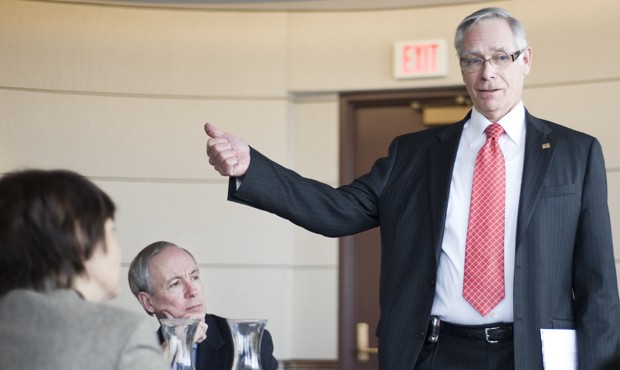In a move that would cut $151 million from the University of MinnesotaâÄôs state aid over the next two years, Gov. Tim Pawlenty proposed a cut Tuesday of more than 8 percent from state higher education for the upcoming 2010-11 biennium. The state faces a nearly $5 billion budget deficit due to falling revenues, a number that is expected to grow in the coming months. At $33.6 billion, PawlentyâÄôs projected budget would be 2.2 percent smaller than that of the current biennium. Pawlenty would reduce the deficit by cutting more than $2.5 billion in spending. He would round out the remainder of the deficit through almost $3.2 billion in revenue increases, including a projected $920 million in federal stimulus money and delayed payments to K-12 education.

There has been speculation that the state could receive more than $3 billion in federal money, a sum that Pawlenty said would contain some money for higher education. Pawlenty said he would continue to push for a cap on tuition increases at state schools at a rate close to inflation, but beyond that would let the UniversityâÄôs Board of Regents and the Minnesota State Colleges and Universities system Board of Trustees determine how to deal with their share of the cut. University President Bob Bruininks said he was disappointed Pawlenty didnâÄôt make higher education a priority in his budget. âÄúI donâÄôt believe you can have a strong, vibrant economy if you donâÄôt make higher education a priority,âÄù he said. While voicing his opposition to the proposed tuition increase cap, Bruininks said students would not face a large tuition increase. âÄúWe have no intention of putting these reductions on the back of students,âÄù he said. In 2003, the state cut more than $198 million from the UniversityâÄôs budget. Tuition increased more than 14 percent each of the two subsequent school years. Bruininks said to avoid similar increases, the University would first look to cut costs and delay investments before raising tuition. Higher education currently makes up more than $3 billion in state expenditures. At 8.5 percent, it would be the fourth largest share of the stateâÄôs general fund in PawlentyâÄôs proposed budget. In announcing his budget, Pawlenty was kicking off a battle with the DFL-controlled state Legislature that is certain to last the duration of the session. Rep. Tom Rukavina , DFL-Virginia and chairman of the House Higher Education and Workforce Development Finance and Policy Division , said the state would need to find additional revenue sources to close out the deficit. âÄúItâÄôs shortsighted on his part,âÄù he said of PawlentyâÄôs higher education cuts. âÄúIâÄôm not going to sit here and nod my head and agree that all of this could be solved with budget cuts.âÄù Sen. Sandy Pappas , chairwoman of the SenateâÄôs higher education finance committee , called the deficit âÄúunprecedented.âÄù While meeting with Bruininks on campus Tuesday, Pappas said the state needs to remain committed to supporting students. âÄúWe donâÄôt want to impact their quality [of education], and we donâÄôt want to make them pay more,âÄù she said. Echoing Rukavina, Pappas said Pawlenty is not âÄúputting everything on the tableâÄù when it comes to finding more revenue sources. âÄúThe governor certainly hasnâÄôt come up with any ideas about how weâÄôre going to maintain the quality of our University while we cut,âÄù Pappas said. âÄúWe have a governor who will not consider all options.âÄù In a statement, Senate Majority Leader Larry Pogemiller, and House Speaker Margaret Anderson Kelliher, both DFL-Minneapolis, said legislative leaders would be willing to consider PawlentyâÄôs proposals during the session. Testifying before RukavinaâÄôs committee on Tuesday, University students and faculty said they would like to see University costs remain low in coming years. âÄúItâÄôs very tough because on one side, as a student, I would love to see my tuition never go above 5.5 percent,âÄù University student Alex Tenenbaum said. âÄúBut on the other hand, I really value that overall payoff from my education thatâÄôs going to come out and mean a lot to me.âÄù When asked his opinion on how to best apply cuts to University funding, student Martin Chorzempa said, âÄúthere really isnâÄôt anything you can cut without huge ramifications throughout the rest of the University.âÄù Nancy Carpenter , a professor of organic chemistry at University of Minnesota-Morris, said students would be a vital part of MinnesotaâÄôs economy in the future. âÄúWe want to make sure that students have a really outstanding education, and theyâÄôre getting it,âÄù she said. âÄúThe young people we work with in my opinion are MinnesotaâÄôs most precious resource, and theyâÄôre our future.âÄù Higher education was not a hallmark of PawlentyâÄôs budget. Areas such health and human services and K-12 education received the bulk of the budgetâÄôs attention. K-12 education received an increase of more than 1 percent in PawlentyâÄôs budget, but he said schools with better performance levels of would receive increased funding in the future. As for healthcare, PawlentyâÄôs budget would give it almost $1 million more in funding in the next biennium. But the departmentâÄôs costs were expected to grow by more than $2.6 million, equating to a cut for the department. -Tara Bannow and Nicole Tommerdahl contributed to this report.







